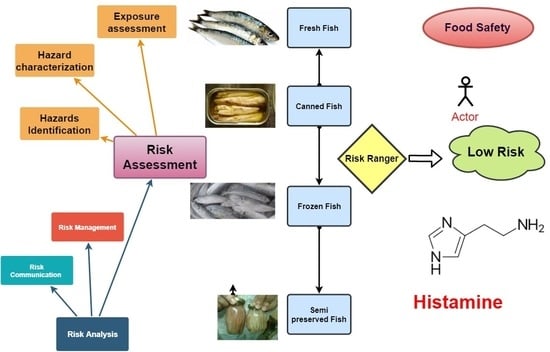Risk Assessment of Histamine in Chilled, Frozen, Canned and Semi-Preserved Fish in Morocco; Implementation of Risk Ranger and Recommendations to Risk Managers
Abstract
1. Introduction
- Severity of the hazard and susceptibility of the population of interest;
- The probability of a disease-causing dose of the hazard being present in a meal;
- The number of meals consumed by a population of interest in a given period [13].
2. Materials and Methods
3. Results and Discussion
3.1. Risk Ranger Questions
3.1.1. Susceptibility and Severity
- Hazard category “Severe” causes death or chronic sequelae in most cases, such as Tetrodotoxins and Botulinum toxin.
- Hazard category “Moderate” in most cases medical treatment is required such as Listeria monocytogenes, Vibrio vulnificus and Vibrio cholerae.
- Hazard category “Mild” where medical treatment is sometimes necessary like Vibrio parahaemolyticus, viral hepatitis, Norwalk virus, Ciguatera, Salmonella and histamine.
- Hazard category “Minor” where medical treatment is rarely required, such as Staphylococcus aureus and Clostridium perfringens.
- The symptoms of allergic reactions are typical to those caused by histamine and often appear within minutes of consuming the food concerned;
- Antihistamine therapy is usually effective and fast in less than eight hours;
- High levels of histamine are often found in fishery products that caused this reaction [20].
- Population category ”General population“ includes all members of the population;
- Population category ”Slightly susceptible” concerns young children (1 to 5 years old) and people over 65 years old. They are ranked 5 times more sensitive than the general population.
- Population category “Very susceptible”: this category includes new-borns, children under one year old and people with diseases such as diabetes, cancer and liver damage, which make them vulnerable to infectious diseases. They are classified 30 times more sensitive than the general population.
- Population category “Extremely susceptible” are people with acquired immunodeficiency (AIDS) or who are recovering from a transplant and have a very weakened immune system. They are 200 times more likely to succumb to risks than the general population.
3.1.2. Probability of Exposure to Hazard in the Food Concerned
- Daily frequency;
- Weekly frequency;
- Monthly frequency;
- A frequency of a few times a year.
- All: if the entire population (100%) consumes this product;
- Most: if 75% of the population consumes this product;
- Some: if 25% of the population consumes this product;
- Very little: if 5% of the population consumes this product.
3.1.3. Probability of Food Containing an Infectious Dose
- Rare: a probability of contamination is classified as rare when the level of contamination is one per thousand;
- Uncommon: when the level of contamination is 1%;
- Sometimes: when the level of contamination is 10%;
- Common: when the level of contamination is 50%;
- All: when the level of contamination is 100%.
- The average histamine concentration is less than 100 mg/kg;
- A maximum of two samples based on the 9 may have histamine contents between 100 and 200 mg/kg;
- No sample should have a histamine content greater than 200 mg/kg.
- The process reliably eliminates the hazard;
- The process generally eliminates the hazard (99% of cases);
- The process slightly reduces (50% of cases) the hazard;
- The process has no effect on the hazard;
- The process increases (10×) the hazard;
- The process greatly increases (1000×) the hazard.
- NO;
- YES—minor (a frequency of 1%);
- YES—major (a frequency of 50%);
- OTHER.
- The canned fish: sterilization is an effective process since it can destroy most of the bacterial flora. Therefore, no increase in histamine levels is observed then, there is no possibility of recontamination after sterilization. The answer is “No”. Canned fish can only be considered safe for recontamination if it is immediately consumed after opening. Many cases of scombroid poisoning have been reported in Italy after eating canned tuna stored open. A common practice of selling scombroid products (mackerel, tuna and anchovies) on the basis of large open cans, often for several days [30].
- Frozen fish: the freezing treatment inhibits the growth of bacteria. In this case, there is no possibility of recontamination after freezing, thus no increase in histamine levels is detected and the answer will be “No”.
- Semi-preserved and fresh fish: there is a possibility of recontamination if the cold chain breaks.
- If good hygiene practices and an adequate, the HACCP (Hazard Analysis Critical Control Point) system is applied, the level of cross-contamination is “No” (A frequency of 0%).
- If an establishment has not followed good practice: by referring to question six, the level of cross-contamination found is low and does not even reach 1%. In addition, most establishments in Morocco set up a HACCP system. Therefore, post-treatment contamination is controlled and a minor potential for recontamination is possible (with a frequency of 1%).
- A first long phase with little or no histamine production. This phase corresponds to the time required for the histamine-producing bacteria to multiply and reach high levels. The importance of this stage depends mainly on the initial bacterial concentration, their growth rate and temperature.
- A second phase where the level increase rapidly. The rate of histamine formation during the second phase corresponds to the activity of high concentrations of histamine-producing bacteria, and is influenced by the storage conditions and the characteristics of the product [39].
- In the case of compliance with good hygiene practices, the level of cross-contamination is No (A frequency of 0%).
- In the case of rupture in the cold chain and a lack of respect for good practices, a minor recontamination potential can occur (with a frequency of 1%).
- Well controlled: when a reliable and effective system is set up, so no increase in pathogen or accumulation of toxin or microorganism occurs.
- Controlled: when a generally reliable and efficient system is put in place, so that there is little multiplication or accumulation (by 3).
- Not controlled: when there is no system (untrained staff) (increase of 10 times).
- Abusive gravity: a large increase of pathogens (1000 times).
- Non-pertinent: the level of hazard does not change.
- None;
- Light (10 times increase);
- Moderate (increase of 100 times);
- Significant (10,000 increase).
- The case of canned, semi-preserved, frozen fish and fresh fish if the cold chain is respected: A significant increase of the germs is necessary to produce histamine intoxications (increase of 107).
- Perishable products requiring cold control: if the cold chain is broken, a significant increase in germs is required to produce histamine intoxication (increase of 106).
3.2. Risk Estimates for Histamine
- A risk ranking by a score between 0 and 100;
- The number of diseases expected annually in the selected population;
- The probability of illness per day in the target population.
- Low risk: risk score below 32;
- Moderate risk: risk score from 32 to 48;
- High risk: risk score higher than 48.
- Increasing capacity and installing new ice factories in all Moroccan ports;
- Subsidizing ice by the state, to make it financially accessible for all wholesalers and fishermen;
- Multiplying the training of fishermen on good hygiene practices and the respect of cold;
- Limiting fishing time to avoid producing high levels of histamine if ice is lacking;
- Strengthening control and inspection along the food chain, especially at the upstreaming of the chain;
- Strengthening the official control of the marketing of fresh fish, especially with respect to the cold chain;
- Increasing the number of consumer awareness campaigns;
- Requiring fish-processing establishments to draw up specifications with fishing vessels for good control of histamine;
- Designing small boats to carry larger amounts of ice (design the fisherman’s seat as hermetic containers);
- Sensitizing fish sellers to good hygienic practices;
- Planning studies that aim to find the secure time fishing depending on water and air temperatures, and on the size and fish species, in order to secure a good control of histamine;
- Raising awareness of boat owners of the importance of ice to preserve not only the marketability but also the safety of fish. The main messages that can be transmitted are:
- Fish must be refrigerated immediately and early once caught;
- Avoid mishandling, overloading and excessive piling of fish, as crushing fish accelerates the spread of histamine-producing bacteria from the intestines, gills and skin to fish muscles;
- Use enough ice to completely wrap the fish to bring the internal temperature of the fish below 4 °C as soon as possible after capture to slow down bacterial growth and enzyme activity;
- The catch volume must not exceed the cooling capacity to be achieved and must maintain the required temperatures.
4. Conclusions
Author Contributions
Funding
Conflicts of Interest
References
- Maintz, L.; Novak, N. Histamine and histamine intolerance. Am. J. Clin. Nutr. 2007, 85, 1185–1196. [Google Scholar] [CrossRef] [PubMed]
- European Food Safety Authority. Assessment of the Incidents of Histamine Intoxication in Some EU Countries; European Food Safety Authority: Parma, Italy, 2017. [Google Scholar] [CrossRef]
- FAO (The Food and Agriculture Organization). Assessment and Management of Seafood Safety and Quality; The Food and Agriculture Organization: Roma, Italy, 2014; Volume 574. [Google Scholar]
- Dalgaard, P.; Emborg, J. Histamine Fish Poisoning—New Information to Control a Common Seafood Safety Issue. In Foodborne Pathogens: Hazards, Risk Analysis and Control, 2nd ed.; Elsevier: New York, NY, USA, 2009. [Google Scholar]
- Prester, L. Biogenic Amines in Fish, Fish Products and Shellfish: A Review. Food Addit. Contam. Part A 2011, 28, 1547–1560. [Google Scholar] [CrossRef] [PubMed]
- Commission Européenne. RÈGLEMENT (CE) No 2073/2005 DE LA COMMISSION Du 15 Novembre 2005 Concernant Les Critères Microbiologiques Applicables Aux Denrées Alimentaires. J. Off. l’Union Eur. 2005, L338, 1–26. [Google Scholar]
- FAO/OMS. Joint FAO/WHO Expert Meeting on the Public Health Risks of Histamine and Other Biogenic Amines from Fish and Fishery Products; FAO/WHO: Rome, Italy, 2013. [Google Scholar]
- Centre Anti Poison du Maroc Ministère de la Santé (CAPM). Rapports Spécifiques de Toxicovigilance; Centre Anti Poison du Maroc Ministère de la santé, Ed.; Centre Anti Poison du Maroc Ministère de la santé Maroc: Rabat, Morocco, 2016. [Google Scholar]
- El Hariri, O.; Bouchriti, N.; Baamal, L.; Bengueddour, R. Fish Consumption, Purchasing Behaviour and Perception of Fish Quality with Especial Reference to Sardine. Int. J. Pharma Bio Sci. 2018, 9, 89–101. [Google Scholar]
- World Health Organization. WHO Human Health Risk Assessment Toolkit: Chemical Hazards; World Health Organization: Geneva, Switzerland, 2010. [Google Scholar]
- Codex Alimentarius. Principes de Travail Pour L’analyse Des Risques En Matière de Sécurité Sanitaire Des Aliments Destinés À Être Appliqués Par Les Gouvernements; FAO/WHO: Rome, Italy, 2007; pp. 1–5. [Google Scholar]
- EFSA. Scientific Opinion on the Development of a Risk Ranking Framework on Biological Hazards. EFSA J. 2012, 10, 1–88. [Google Scholar] [CrossRef]
- Food and Agriculture Organization (FAO). Application of Risk Assessment in the Fish Industry; FAO: Rome, Italy, 2004. [Google Scholar]
- Guillier, L.; Thébault, A.; Gauchard, F.; Pommepuy, M.; Guignard, A.; Malle, P. A risk-based sampling plan for monitoring of histamine in fish products. J. Food Prot. 2011, 74, 302–310. [Google Scholar] [CrossRef] [PubMed]
- Ross, T.; Sumner, J. A simple, spreadsheet-based, food safety risk assessment tool. Int. J. Food Microbiol. 2002, 77, 39–53. [Google Scholar] [CrossRef]
- Lehane, L.; Olley, J. Histamine fish poisoning revisited. Int. J. Food Microbiol. 2000, 58, 1–37. [Google Scholar] [CrossRef]
- Taylor, S.L.; Eitenmiller, R.R. Histamine food poisoning: toxicology and clinical aspects. Crit. Rev. Toxicol. 1986, 17, 91–128. [Google Scholar] [CrossRef] [PubMed]
- NSW Government. Risk Assessment of the Seafood Safety Scheme; NSW Government: Silverwater, Australia, 2017.
- Hungerford, J.M. Scombroid poisoning: A review. Toxicon 2010, 56, 231–243. [Google Scholar] [CrossRef] [PubMed]
- Lerke, P.A.; Werner, S.B.; Taylor, S.L.; Guthertz, L.S. Scombroid poisoning. Report of an outbreak. West. J. Med. 1978, 129, 381–386. [Google Scholar] [PubMed]
- HCP. Population Légale D’après Les Résultats Du RGPH 2014 Sur Le Bulletin Officiel N° 6354. Available online: https://rgph2014.hcp.ma/file/167576/ (accessed on 31 August 2018).
- El Hariri, O.; Bouchriti, N.; Bengueddour, R. Occurrence et Évaluation Du Risque de L’histamine Dans Les Produits de La Peche Commercialises Sur Le Marché Marocain. Eur. Sci. J. 2017, 13, 225–250. [Google Scholar] [CrossRef]
- ONSSA. Loi n°28-07 Relative À La Sécurité Sanitaire Des Produits Alimentaires, Promulguée Par Le Dahir n°1-10-08 Du 26 Safar 1431 (11 Février 2010). Available online: http://pampat.ma/wp-content/uploads/2015/09/LOI.28-07.FR_.pdf (accessed on 31 August 2018).
- Ababouch, L.; Afilal, M.E.; Ustas, F.F.B. Quantitative changes in bacteria, amino acids and biogenic amines in Sardine (Sardina pilchardus) stored at ambient temperature (25–28 °C) and in ice. Int. J. Food Sci. Technol. 1991, 26, 297–306. [Google Scholar] [CrossRef]
- Shalaby, A.R. Significance of biogenic amines to food safety and human health. Food Res. Int. 1996, 29, 675–690. [Google Scholar] [CrossRef]
- FDA. Fish and Fishery Products Hazards and Controls Guidance, 4th ed.; Department of Health and Human Services: Gainesville, FL, USA, 2011; pp. 1–401.
- Kanki, M.; Yoda, T.; Tsukamoto, T.; Baba, E. Histidine decarboxylases and their role in accumulation of histamine in tuna and dried saury. Appl. Environ. Microbiol. 2007, 73, 1467–1473. [Google Scholar] [CrossRef] [PubMed]
- Arnold, S.H.; Brown, W.D. Histamine toxicity from fish products. Adv. Food Res. 1978, 24, 113–154. [Google Scholar] [PubMed]
- Kim, S.H.; Wei, C.I.; Clemens, R.A.; An, H. Review: Histamine Accumulation in Seafoods and Its Control to Prevent Outbreaks of Scombroid Poisoning. J. Aquat. Food Prod. Technol. 2004, 13, 81–100. [Google Scholar] [CrossRef]
- Piersanti, A.; Tavoloni, T.; Lestingi, C.; Galarini, R. High-throughput histamine analysis approach in an official control laboratory: Analytical methods and four years fish products results. Food Chem. 2014, 153, 437–443. [Google Scholar] [CrossRef] [PubMed]
- Food and Agriculture Organization (FAO). Elaboration Des Semi Conserves D’anchois: Aspects Économiques, Techniques et Hygiéniques; FAO: Rome, Italy, 2009. [Google Scholar]
- Hernández-Herrero, M.M.; Roig-Sagués, A.X.; Rodríguez-Jerez, J.J.; Mora-Ventura, T.M. Halotolerant and Halophilic Histamine-Forming Bacteria Isolated during the Ripening of Salted Anchovies (Engraulis Encrasicholus). J. Food Prot. 1999, 62, 509–514. [Google Scholar] [CrossRef] [PubMed]
- La Pietra, L.; Belfiore, A.; De Sio, F.; Lo Voi, A.; Pirone, G. Identification and Characterization of Halophilic Bacteria from Anchovy Paste. Ind. Conserv. 2014, 2, 29–35. [Google Scholar]
- Veciana-Nogues, M.T.; Vidal-Carou, M.C.; Marine-Font, A. Histamine and Tyramine in Preserved and Semi-preserved Fish Products. J. Food Sci. 1989, 54, 1653–1655. [Google Scholar] [CrossRef]
- Vasconi, M.; Bellagamba, F.; Bernardi, C.; Martino, P.A.; Moretti, V.M. Histamine Formation in a Dry Salted Twaite Shad (Alosa Fallax Lacustris) Product. J. Food Prot. 2017, 80, 127–135. [Google Scholar] [CrossRef] [PubMed]
- Ababouch, L.H.; Souibri, L.; Rhaliby, K.; Ouahdi, O.; Battal, M.; Busta, F.F. Quality Changes in Sardines (Sardina Pilchardus) Stored in Ice and at Ambient Temperature. Food Microbiol. 1996, 13, 123–132. [Google Scholar] [CrossRef]
- El Marrakchi, A.; Bennour, M.; Bouchriti, N.; Hamama, A.; Tagafait, A. Sensory, Chemical, and Microbiological Assessments of Moroccan Sardines (Sardina Pilchardus) Stored in Ice. J. Food Prot. 1990, 53, 600–605. [Google Scholar] [CrossRef]
- El Hariri, O.; Abdalah, E.H.; Bouchriti, N.; Youssef, C.; Bengueddour, R. Effects of Soaking in a Chlorine Solution on Sensory, Chemical and Microbiological Quality and on the Histamine Levels in Sardine (Sardina Pilchardus). J. Pharma Bio Sci. 2018, in press. [Google Scholar]
- Dalgaard, P.; Emborg, J.; Kjølby, A.; Sørensen, N.D.; Ballin, N.Z. Histamine and Biogenic Amines: Formation and Importance in Seafood. In Improving Seafood Products for the Consumer; Børresen, T., Ed.; British Welding Research Association: Cambridge, UK, 2008; pp. 292–324. [Google Scholar]
- Ababouch, L.; Afilall, M.E.; Rhafiri, S.; Busta, F.F.; Microbiologic, D.D.; Hassan, V. Identification of Histamine-Producing Bacteria Isolated from Sardine (Sardina pilchardus) Stored in Ice and at Ambient Temperature (25 °C). Food Microbiol. 1991, 8, 127–136. [Google Scholar] [CrossRef]
- Ababouch, L.; Alaoui, M.M.; Busta, F.F. Histamine Levels in Commercially Processed Fish in Morocco. J. Food Prot. 1986, 49, 904–908. [Google Scholar] [CrossRef]
- Ababouch, L.; Afilal, M.E. L’ Histamine Dans La Sardine Marocaine fraTche et En Conserves. MIRCEN J. 1989, 5, 77–86. [Google Scholar] [CrossRef]
- Fletcher, G.C.; Summers, G.; van Veghel, P.W.C. Levels of Histamine and Histamine-Producing Bacteria in Smoked Fish from New Zealand Markets. J. Food Prot. 1998, 61, 1064–1070. [Google Scholar] [CrossRef] [PubMed]
- El Hariri, O.; Bouchriti, N.; Bengueddour, R. Analyse Des Notifications Du Système RASFF Pour L’histamine Dans Les Produits de La Pêche Sur Une Période de 11 Ans: Situation Internationale et Cas Du Maroc. Rev. Marocaine Sci. Agron. Vét. 2018, 6, 374–390. [Google Scholar]
- MAPM. Guides de Bonnes Pratqiues D’hygiène et D’application Des Principes HACCP Vol 1 Bateaux de Pêche Débarquement de La Pêche; Ministère de l’Agriculture et de la Pêche Maritime, Ed.; Ministère de l’Agriculture et de la Pêche Maritime Département de la Pêche Maritime: Rabat, Morocco, 2010.
- Ministère de l’Agriculture et de la Pêche Maritime Département de la Pêche Maritime (MAPM). GBPH Vol 2 Production de Glace; Ministère de l’Agriculture et de la Pêche Maritime Département de la Pêche Maritime: Rabat, Morocco, 2010.
- Département de la Pêche Maritim (DPM). Ibhar Programme de Mise À Niveau et de Modernisation de La Flotte Côtière et Artisanale; Département de la Pêche Maritime: Rabat, Morocco, 2008.
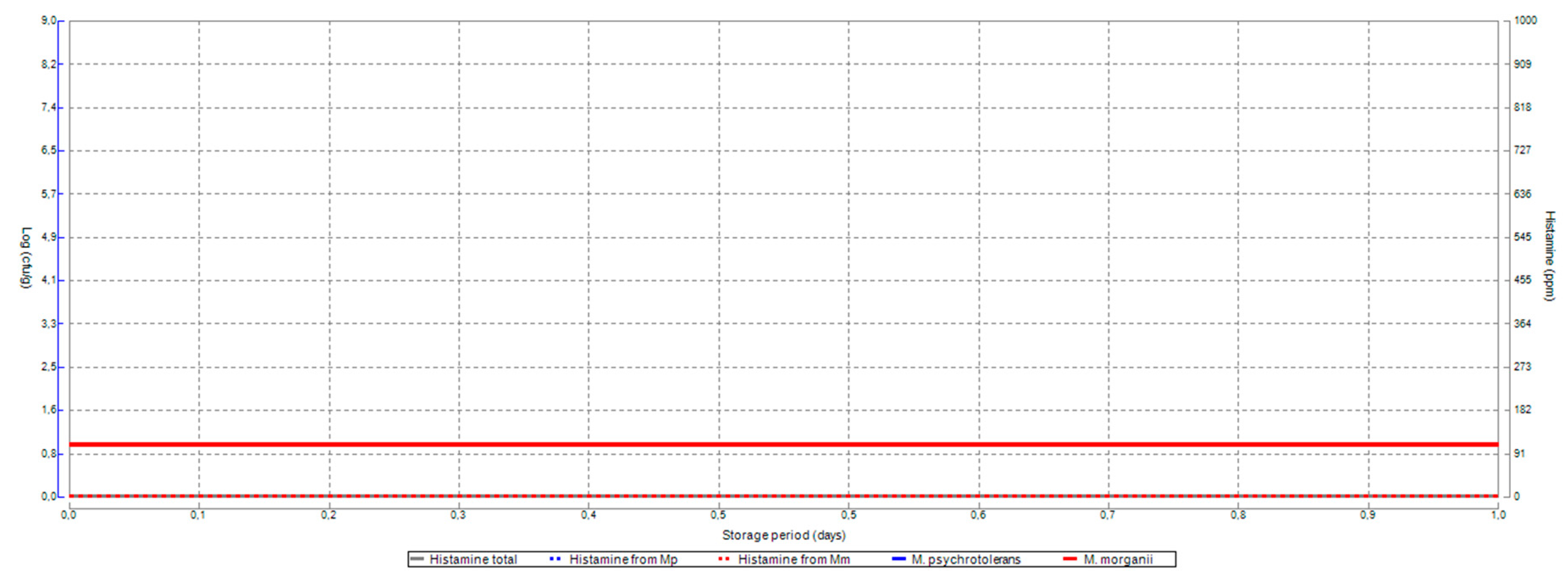
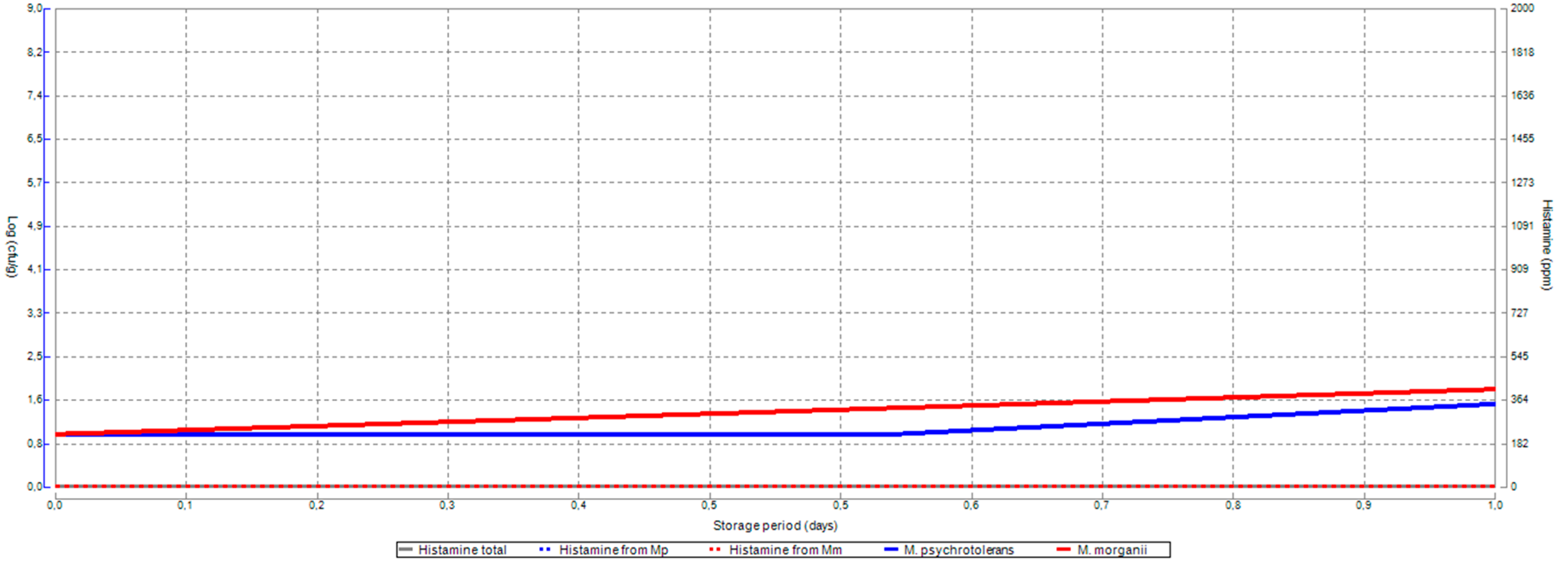
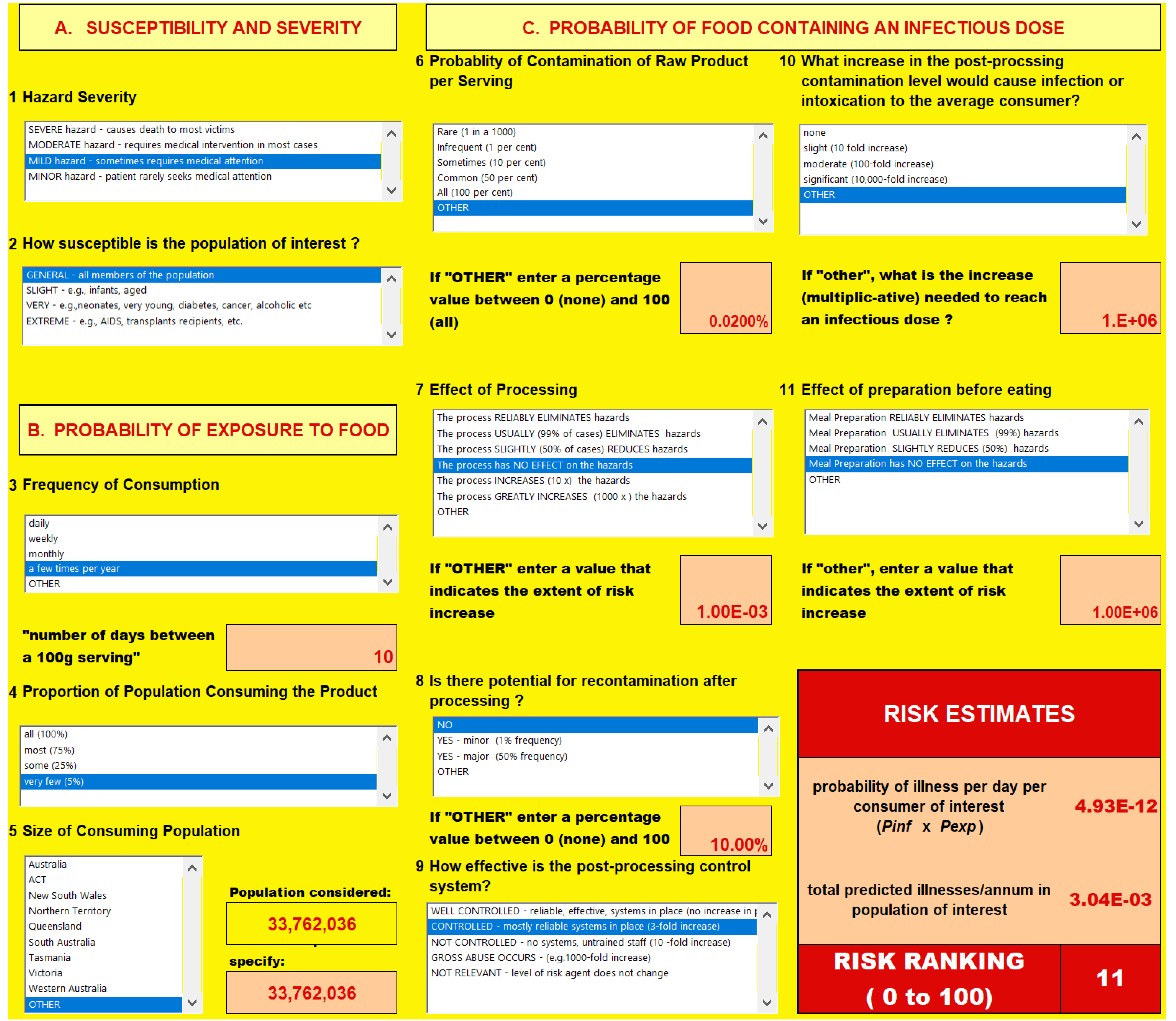

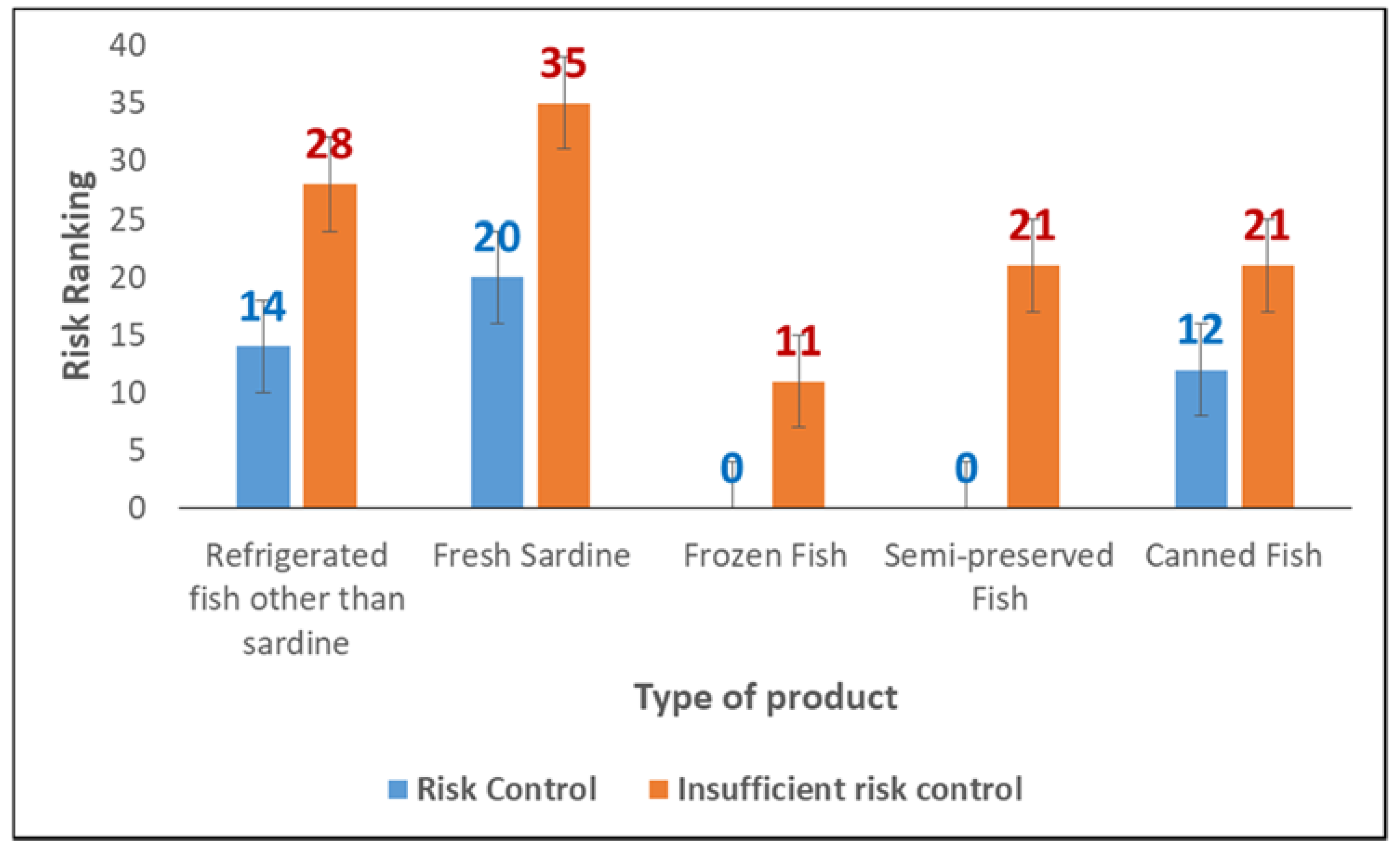
| Nature of Products | Analyses Number | 2013 | 2014 | 2015 | Total | Rate of Non-Compliance (%) |
|---|---|---|---|---|---|---|
| Canned fish | Realized | 21,459 | 15,203 | 4466 | 41,128 | 0.0049 |
| Non-Compliant | 0 | 2 | 0 | 2 | ||
| Semi-preserved fish | Realized | 14,985 | 15,057 | 7209 | 37,251 | 0.024 |
| Non-Compliant | 5 | 2 | 2 | 9 | ||
| Fresh fish | Realized | 18 | 2 | 54 | 74 | 0 |
| Non-Compliant | 0 | 0 | 0 | 0 | ||
| Frozen fish | Realized | 15,672 | 11,916 | 1962 | 29,550 | 0.020 |
| Non-Compliant | 3 | 0 | 3 | 6 | ||
| Total | Realized | 52,134 | 42,178 | 13,691 | 108,003 | 0.016 |
| Non-Compliant | 8 | 4 | 5 | 17 |
| Product | Score Minimum | Score Maximum | Calculation of Rank Reduction | Risk Reduction Estimate (Number of Patient/Year) |
|---|---|---|---|---|
| Refrigerated fish other than sardine | 14 | 28 | 14 | 100 |
| Refrigerated sardine | 20 | 35 | 15 | 100 |
| Canned fish | 12 | 21 | 9 | 100 |
| Semi-preserved fish | 0 | 21 | 21 | 1000 |
| Frozen fish | 0 | 11 | 11 | 10 |
© 2018 by the authors. Licensee MDPI, Basel, Switzerland. This article is an open access article distributed under the terms and conditions of the Creative Commons Attribution (CC BY) license (http://creativecommons.org/licenses/by/4.0/).
Share and Cite
El Hariri, O.; Bouchriti, N.; Bengueddour, R. Risk Assessment of Histamine in Chilled, Frozen, Canned and Semi-Preserved Fish in Morocco; Implementation of Risk Ranger and Recommendations to Risk Managers. Foods 2018, 7, 157. https://doi.org/10.3390/foods7100157
El Hariri O, Bouchriti N, Bengueddour R. Risk Assessment of Histamine in Chilled, Frozen, Canned and Semi-Preserved Fish in Morocco; Implementation of Risk Ranger and Recommendations to Risk Managers. Foods. 2018; 7(10):157. https://doi.org/10.3390/foods7100157
Chicago/Turabian StyleEl Hariri, Oleya, Nourredine Bouchriti, and Rachid Bengueddour. 2018. "Risk Assessment of Histamine in Chilled, Frozen, Canned and Semi-Preserved Fish in Morocco; Implementation of Risk Ranger and Recommendations to Risk Managers" Foods 7, no. 10: 157. https://doi.org/10.3390/foods7100157
APA StyleEl Hariri, O., Bouchriti, N., & Bengueddour, R. (2018). Risk Assessment of Histamine in Chilled, Frozen, Canned and Semi-Preserved Fish in Morocco; Implementation of Risk Ranger and Recommendations to Risk Managers. Foods, 7(10), 157. https://doi.org/10.3390/foods7100157




